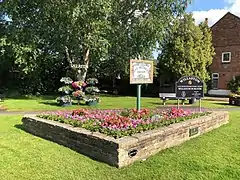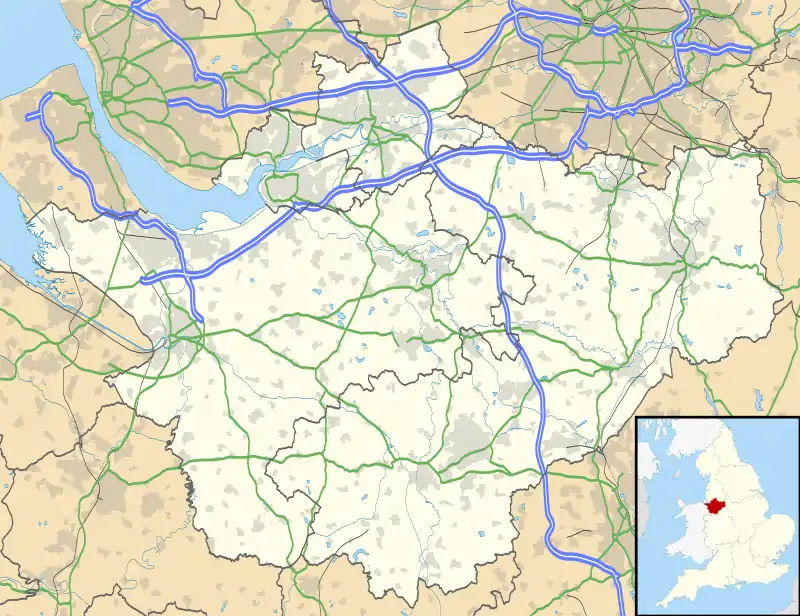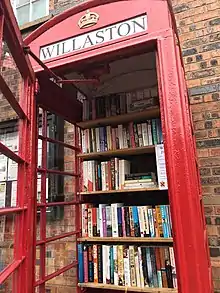| Willaston | |
|---|---|
 Mike Heywood Green Willaston | |
 Willaston Location within Cheshire | |
| Population | 3,104 (2011 census)[1] |
| OS grid reference | SJ682539 |
| Civil parish |
|
| Unitary authority | |
| Shire county | |
| Region | |
| Country | England |
| Sovereign state | United Kingdom |
| Post town | Crewe |
| Postcode district | CW5 |
| Dialling code | 01270 (Crewe) |
| Police | Cheshire |
| Fire | Cheshire |
| Ambulance | North West |
| UK Parliament | |
Willaston is a civil parish and village in the unitary authority of Cheshire East and the ceremonial county of Cheshire, in north-west England. It had a population of 3,104 at the time of the 2011 census,[1] up from 2,973 in 2001.[2]
Willaston is approximately 3 miles (4.8 km) southwest of Crewe town centre and 2 miles (3.2 km) east of Nantwich town centre. It is approximately 7 miles (11.3 km) from junction 16 of the M6 motorway and 3 miles (4.8 km) from Crewe railway station.
Governance
From 1974 to 2009 the borough council was Crewe and Nantwich. Since abolition on 1 April 2009, the civil parish has been administered by the unitary authority of Cheshire East.[3]
Willaston Parish Council was established in 1894 and is the first tier of local government for Willaston. It is responsible for the management of the Lettie Spencer playing field, the war memorial on Colleys Lane, the village allotments on Crewe Road, the Spinney off Coppice Road, and Mike Heywood Green. The council is made up of 12 members from two wards who represent the interests of all Willaston residents. The Parish Council is a planning consultee and author of the Willaston neighbourhood plan which informs local planning decisions.[4]
Willaston falls in the parliamentary constituency of Crewe and Nantwich,[5] which has been represented by Kieran Mullan since the 2019 General Election.
History of Willaston
Willaston is believed to have taken its name from an ancient farmstead known as Wiglaf's tun. Like other English villages, the name has been changed many times over the centuries. This is due to the neighbouring parish of Wistaston having a similar sounding name. To add confusion, Willaston was once ecclesiastically divided between the neighbouring communities of Nantwich and Wybunbury.
Whilst there are at least two other villages called Willaston, the earliest documentary evidence relating to Willaston in this part of Cheshire can be found in the Domesday survey of 1086, where is it referred to as Wilavestune, owned by a 'free man' named Ulviet. A few years after the Norman conquest the title passed to Willam Malbank. The manor of Wilvastune remained in the Malbank family for several generations before ownership transferred to the Chanu family in the 13th century.
At this time, Willaston was a remote, sparsely populated community with no village centre. Nevertheless, it covered a much larger area than it does today, stretching from Newcastle Road and London Road, Nantwich in the south, along Millstone Lane and as far as the ancient grazing land of Beam Heath in the north. These boundaries did not change until 1936, when local government decided to transfer some of Willaston's land to the expanding communities of Nantwich and Stapeley. In 1553, the manor of Willaston was bought by Richard Sneyd, Recorder of Chester. The Sneyd family lived at Keele Hall in Staffordshire and were the major landowners in Willaston until the middle of the 19th century.
Although Willaston had a number of farmsteads in the Middle Ages, most of the surrounding landscape was uncultivated. However, this began to change as more common land fell into private ownership during the late 18th and early 19th centuries. The process (known as 'enclosure') brought major changes to rural communities like Willaston, as individual plots of land were fenced off and used for arable farming, meadows and the grazing of livestock. The Sneyd family were absentee landlords but they owned most of the lands in Willaston from 1533 to the late 19th century.
The medieval moated site of the Chanu family was lost during the construction of the Nantwich by-pass in 1989. It was situated to the south-east of the Old Willaston Board School on land now owned by Cheerbrook Farm.[6]
Local amenities
The village centre of Willaston has two public houses (The Lamb and The Nag's Head) and a social club, while an off-licence provides local produce and day to day goods. Another pub, The Peacock, is situated to the north-west of the village centre, on Crewe Road (the A534). Alongside The Peacock pub is a hotel operated by Premier Inn.
The social club offers many social events ranging from a monthly kids disco to various tribute bands and acts. The club has two pool teams, a snooker team, two 7-a-side football teams, a darts and dominoes team and a ladies darts team. In summer 2013 the function room (available for hire) was refurbished.
The village also has a fish and chip shop (Mick the chips) and hairdressing salons. Other local businesses provide employment, including Scanlans and SJB Steel; at the edge of the village is a farm shop, Cheerbrook,[7] on Newcastle Road; a plant nursery and garden centre is located on Crewe Road.
Willaston Primary School[8] is the only education establishment in the village. For children of pre-school age, there is an Ofsted registered playgroup in the village.
A K6 telephone box in Wistaston Road has been in place since the late 1940s. Decommissioned by British Telecom in 2010, it was then purchased by Willaston Parish Council and turned into a book exchange, the 'book box'. A restoration was carried out in September 2019.

The Willaston WI sign is located on Mike Heywood Green on Wistaston Road. The sign was gifted by the Willaston branch of the Women's Institute in November 1970.
Local events

One of the major events in Willaston is the World Worm Charming Championships. It was started in 1980 by John Bailey and the first event was won with a total of 511 worms by Tom Shufflebotham - a record that stood until 2009.
The event attracts many competitors from around the world, from the US to Australia. Celebrities that have taken part include Ben Fogle and Bob Carolgees; in 2008 contestants Paddy McGuinness and Rory McGrath filmed a slot for the series Rory and Paddy's Great British Adventure.[9]
The 2008 championship was won by Mike and Claire Gaukroger with a total of 125 worms; the trophy for the heaviest worm went to Ray O'Grady and Steve Plant (4.6g).[10]
In 2009, in particularly good conditions, three teams broke the previous world record of 511. Sophie Smith and Matt Smith of Willaston claimed the title with a total of 567 worms in 30 minutes.[11]
See also
References
- 1 2 UK Census (2011). "Local Area Report – Willaston Parish (E04011024)". Nomis. Office for National Statistics. Retrieved 4 January 2021.
- ↑ UK Census (2001). "Local Area Report – Willaston Parish (13UD063)". Nomis. Office for National Statistics. Retrieved 4 January 2021.
- ↑ Cheshire (Structural Changes) Order 2008
- ↑ Willaston Parish Council, Willason Parish Council Website. Retrieved: 30 October 2019.
- ↑ Cheshire County Council: Interactive Mapping: Crewe and Nantwich. Retrieved 27 January 2009.
- ↑ "Willaston Parish Plan - History of Willaston" (PDF). Willaston Parish Council.
- ↑ Cheerbrook Farm's Official Website. Retrieved 31 January 2009.
- ↑ Willaston Primary School Website . Retrieved May 18th 2010.
- ↑ "Demand Five | watch Rory & Paddy's Great British Adventure, Series 1 - episode 3, Episode 3". Demand.five.tv. Retrieved 30 June 2009.
- ↑ Nicola King on behalf of I.F.C.W.A.P. "The World Worm Charming Championships". Wormcharming.com. Archived from the original on 4 May 2009. Retrieved 30 June 2009.
- ↑ Langley, William (28 June 2009). "The charms of worm charming". The Daily Telegraph. London.
External links
![]() Media related to Willaston, Cheshire East at Wikimedia Commons
Media related to Willaston, Cheshire East at Wikimedia Commons